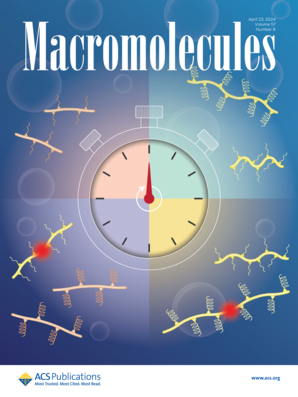Evolution of Crystalline Morphology in Ultrathin Films of Copolyesters with Controlled Rigid Dihydric Alcohol Contents
IF 5.1
1区 化学
Q1 POLYMER SCIENCE
引用次数: 0
Abstract
The isothermal crystalline morphology of random copolyesters, PTTxGy, prepared by polycondensation of terephthalic acid with mixtures of 1,3-propylene glycol (1,3-PDO, T) and 1,4-cyclohexanedimethanol (1,4-CHDM, G) in different molar ratios, was studied by atomic force microscopy (AFM). The results show that with an increasing molar ratio of the rigid component (G) in the dihydric alcohol, the size of the lamellar crystals in ultrathin films initially increased, followed by the formation of stacked lamellae, where the number of stacking layers progressively increased. The lamellar thickness also increased from 5.6 nm in PTT (0% G) to 12.2 nm in PTT85G15 (15% G) after crystallization at 195 °C. These phenomena are attributed to the inhibition of nucleation in the film with the increase of the G component. Consequently, the crystal size increased, while the crystal density decreased. This further makes the lamellar crystals to nucleate and grow on top of a basal lamellar crystal, forming correlated lamellar crystals. Exclusion of the G component from the crystal results in more tails and loops on the lamellar surface and forms thicker amorphous layers on two sides of the crystal; therefore, the lamellar thickness measured by AFM was increased. The effect of the number of nuclei on the formation of correlated lamellar crystals was further demonstrated through a two-step crystallization procedure. As the number of crystal nuclei increased, the degree of stacking and crystal size decreased until a monolayer of lamellae formed after crystallization at 195 °C. This paper highlights the role of the polymer chemical structure in the resulting crystalline morphology of ultrathin films.

控制刚性二水醇含量的共聚酯超薄膜的结晶形态演变
采用原子力显微镜(AFM)研究了对苯二甲酸与不同摩尔比的1,3-丙二醇(1,3- pdo, T)和1,4-环己二甲醇(1,4- chdm, G)的混合物缩聚制备的随机共聚酯PTTxGy的等温结晶形貌。结果表明:随着二水醇中刚性组分G摩尔比的增大,超薄膜中的片层晶体尺寸先增大,然后形成叠片,叠片层数逐渐增加;195℃结晶后,PTT (0% G)的片层厚度由5.6 nm增加到12.2 nm (15% G)。这些现象归因于随着G组分的增加,膜中的成核受到抑制。因此,晶体尺寸增大,而晶体密度减小。这进一步使片层晶体成核并生长在基片层晶体之上,形成相关的片层晶体。从晶体中排除G组分导致片层表面出现更多的尾和环,并在晶体两侧形成更厚的非晶层;因此,原子力显微镜测得的片层厚度增加。通过两步结晶过程进一步证明了核数对相关片层晶体形成的影响。随着晶核数的增加,堆积程度和晶体尺寸减小,直至195℃结晶后形成单层片层。本文重点讨论了聚合物的化学结构对超薄膜结晶形态的影响。
本文章由计算机程序翻译,如有差异,请以英文原文为准。
求助全文
约1分钟内获得全文
求助全文
来源期刊

Macromolecules
工程技术-高分子科学
CiteScore
9.30
自引率
16.40%
发文量
942
审稿时长
2 months
期刊介绍:
Macromolecules publishes original, fundamental, and impactful research on all aspects of polymer science. Topics of interest include synthesis (e.g., controlled polymerizations, polymerization catalysis, post polymerization modification, new monomer structures and polymer architectures, and polymerization mechanisms/kinetics analysis); phase behavior, thermodynamics, dynamic, and ordering/disordering phenomena (e.g., self-assembly, gelation, crystallization, solution/melt/solid-state characteristics); structure and properties (e.g., mechanical and rheological properties, surface/interfacial characteristics, electronic and transport properties); new state of the art characterization (e.g., spectroscopy, scattering, microscopy, rheology), simulation (e.g., Monte Carlo, molecular dynamics, multi-scale/coarse-grained modeling), and theoretical methods. Renewable/sustainable polymers, polymer networks, responsive polymers, electro-, magneto- and opto-active macromolecules, inorganic polymers, charge-transporting polymers (ion-containing, semiconducting, and conducting), nanostructured polymers, and polymer composites are also of interest. Typical papers published in Macromolecules showcase important and innovative concepts, experimental methods/observations, and theoretical/computational approaches that demonstrate a fundamental advance in the understanding of polymers.
 求助内容:
求助内容: 应助结果提醒方式:
应助结果提醒方式:


